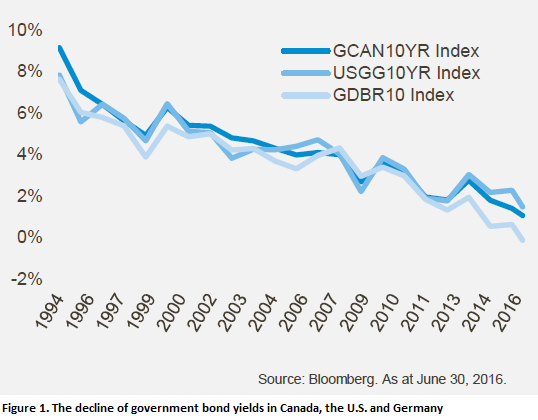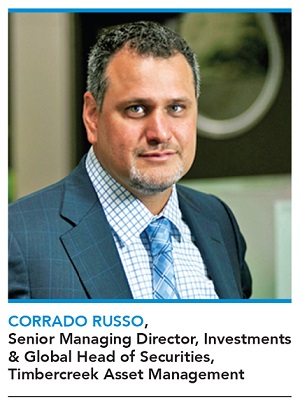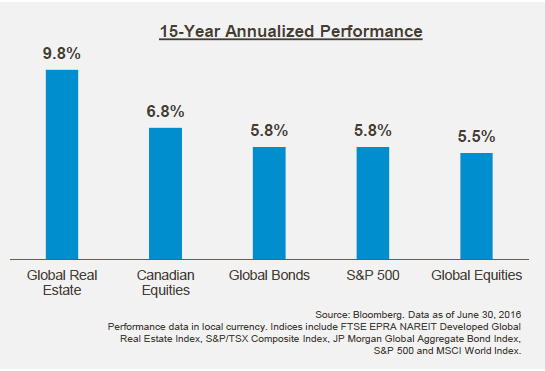Investors today face challenges that can only be overcome with innovative thinking. Real estate, whether in the form of private, direct investments or publicly traded companies via mutual funds, is particularly fertile ground for the out-of-the-box solutions investors need.
A large proportion of investors have three main priorities when it comes to building a portfolio:
1) income, 2) diversification and 3) capital preservation through low volatility, but with meaningful growth. For decades, the standard approach to meeting these goals was the 60% equity, 40% fixed-income portfolio. There is increasing recognition that this approach is no longer adequate.
Today’s key challenges
The inability of the old formula to deliver in today’s environment stems from structurally low yields offered by developed-country government bonds – once a reliable source of safe, robust fixed-income returns. Figure 1, below, shows just how much yield has been sapped from client portfolios in the past 20 years.

Exacerbating the new normal of low yields is increasing volatility in equity markets. For example, Bloomberg data shows that between 1985 and 1999, there were almost 800 days when the S&P 500 Index saw market fluctuations of greater than 1%. For the years 2000 through 2015, that number jumps to over 1,200.
Done correctly, real estate investing can help dampen volatility and provide enhanced income streams for client portfolios.
Real estate advantage
One of the reasons real estate is so attractive is that the income it generates is not fixed. “With strong active management, real estate income can grow over time, typically at the pace of inflation – or slightly higher,” says Corrado Russo, Senior Managing Director, Investments & Global Head of Securities, Timbercreek Asset Management, a global asset manager specializing in real estate.

Real estate income is predictable and transparent because it’s based on long-term leases. For instance, a large mall anchored by a high-end retailer in an affluent neighbourhood will generate high, consistently growing rents with a very low probability of delinquency.
It’s a winning formula, which is why global real estate companies’ annualized performance of 9.8% over the past 15 years beats Canadian equities (6.8%), global bonds (5.8%), the S&P 500 Index (5.8%) and global equities (5.5%).1

But security selection is key. While global real estate as a whole should currently be expected to generate income of about 4%, strong active management can yield 6% to 7%. One of the ways this is accomplished is by stripping out securities that are known to detract from income. For example, real estate developer stocks and emerging market real estate stocks tend not to pay strong dividends; an effective active manager will screen them out.
Strong active management is also a guard against what’s commonly viewed as real estate’s Achilles heel: rising interest rates. To offset this potential headwind, an experienced real estate fund manager will take a number of steps, including buying companies with attractive cash-flow growth. Additionally, from a historical perspective, interest rates tend to rise when economies strengthen, which drives increased cash flow for real estate companies. This growth often trumps the effect of rising rates.

Diversification and low volatility
Building a diversified portfolio through low- or non-correlated assets has long been the cornerstone of security selection. For decades, this was accomplished with a simple stock and bond allocation. But recent years have seen a tightening of correlations between equities and fixed income, leading investors to search for other ways of achieving the diversification they need to weather turbulent markets.
Real estate – both private and publicly traded – delivers diversification through low correlations to traditional asset classes. For instance, Canadian real estate has only a 0.52 correlation to Canadian equities, and a 0.5 correlation to U.S. equities.2
Complementing real estate’s diversification benefits is the low-volatility return path that’s so important to investors focused on capital preservation. “Long-term leases have a major smoothing effect on cash flows, whereas general equities’ cash flows go up and down with the economy,” explains Russo.
Meeting investor needs
Strong, reliable income. Diversification. Capital preservation through low volatility, plus meaningful growth.
Global real estate delivers on each of these investor priorities at a time when traditional assets fail to pull the weight they once did. And when paired with experienced active management, real estate can go well beyond replacing the income streams lost in today’s low-yield environment.
Timbercreek Asset Management is a global expert in private and publicly traded real estate investments, focused on delivering predictable, sustainable and growing returns to investors.
For more information on Timbercreek’s investment solutions, visit Timbercreek.com/advisors
1 Source: Bloomberg. Data as of June 30, 2016. Performance data in local currency. Indices include FTSE EPRA NAREIT Developed Global Real Estate Index, S&P/TSX Composite Index, JP Morgan Global Aggregate Bond Index, S&P 500 Index and MSCI World Index.
2 Source: Bloomberg. Data as at December 31, 1992 to January 31, 2016.
Partner Reports is a space made available for businesses who wish to publish content for the financial professionals. Investment Executive journalists are not involved in writing these articles.